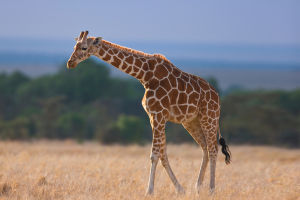
Lykkers, we all know that giraffes are famous for their long necks, but have you ever wondered why they evolved to have such an extraordinary feature? Most people think that their long necks help them reach high trees to feed.
While this might seem like the obvious answer, the real reason might surprise you. Let's break down the fascinating truth behind giraffes' evolution!
The Early Theories: Lamarck and Darwin
For a long time, many believed that giraffes evolved their long necks to help them feed from tall trees—a concept originally proposed by French naturalist Jean-Baptiste Lamarck. In his 1809 work Philosophie Zoologique, Lamarck suggested that giraffes, living in dry and poor environments, needed to stretch their necks to reach leaves high in the trees. Over generations, this constant stretching caused their necks to become longer.
Charles Darwin, the famous British naturalist, also believed that giraffes' necks were related to their feeding habits. However, Darwin argued that their long necks were the result of natural selection, not the result of stretching. He proposed that giraffes with longer necks had a better chance of survival during tough times and were more likely to pass on their long neck genes to future generations.
The Problem with the Old Idea
While Lamarck's and Darwin's theories shaped much of our understanding, it turns out that the feeding theory is not entirely accurate. Over time, scientists began to realize that giraffes are not always feeding on the highest trees.
In fact, during dry seasons, giraffes mostly feed on low shrubs rather than tall trees. And when they do eat from trees, they often bend their necks to reach the branches, which is much faster and easier than stretching their necks to the highest points.
In 1996, zoologists Robert Simmons and Lou Shipman questioned the traditional "feeding theory." They pointed out that giraffes are more likely to eat from lower vegetation, especially when resources are scarce. This raised a big question: Why would giraffes evolve to have necks that are so much longer than necessary for eating?
The Surprising New Hypothesis: Mating Selection
Simmons and Shipman introduced a bold new idea: giraffes' long necks might be the result of mating selection rather than natural selection for feeding.
They suggested that male giraffes use their necks in fights to compete for mates, a behavior known as “necking.” During these fights, males swing their heads like heavy clubs, striking their opponents with tremendous force. The males with longer, stronger necks are more likely to win these battles and get access to mates.
This theory makes a lot of sense when you consider that male giraffes have significantly longer necks than females. The idea is that longer necks help males demonstrate their strength and dominance, which are attractive traits to females.
Real-Life Examples of Necking Battles
To understand just how crucial necking is for male giraffes, we don't have to look far. In the 1960s, researchers observed an intense battle between two male giraffes. One male struck the other so hard that it broke the opponent's neck. This behavior is a sign of strength and dominance, and the victor gets to mate with the females. It's clear that the neck is not just for feeding—it's a weapon for winning mates.
Why Do Giraffes Evolve This Way?
So, why did giraffes evolve such long necks in the first place? Well, it seems that mating selection played a big role. Males with longer necks can defend their territory, dominate other males, and win over females. As time went on, this trait became more pronounced because it gave those males an advantage in reproductive success.
Interestingly, females also prefer males with bigger necks, further reinforcing this trait. As a result, mating selection has shaped the giraffes' necks over millions of years, turning what was once just a practical trait into a symbol of fitness and attraction.
Final Thoughts on Giraffe Evolution
It's amazing to think that a feature as iconic as the giraffe's long neck might not be all about feeding after all. Instead, it seems like these majestic creatures have evolved their unique necks to help compete for mates, demonstrating once again how evolution works in mysterious and unexpected ways.
Lykkers, what do you think of this new perspective? Do you find it surprising that giraffes' long necks are more about competition for love than food? Let's chat about it in the comments!


